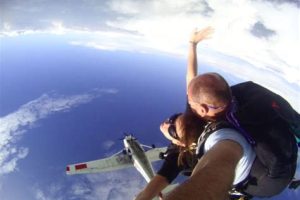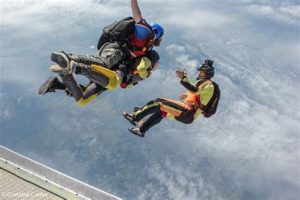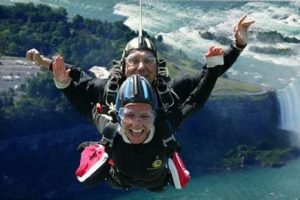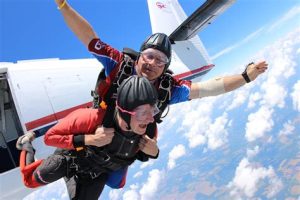Table of Contents
Tandem skydiving vs skydiving: Discover the differences between these thrilling experiences. Tandem skydiving allows you to enjoy the adrenaline rush of freefall while securely harnessed to an experienced instructor. Skydiving, on the other hand, involves solo jumps after completing training. Compare the two options and choose the perfect adventure for your skydiving aspirations.
Tandem skydiving and skydiving are two thrilling activities that offer the ultimate adrenaline rush. Whether you’re a daredevil seeking an exhilarating experience or simply looking to conquer your fear of heights, these extreme sports will surely get your heart pumping. However, it’s important to understand the key differences between tandem skydiving and skydiving on your own. In this article, we will delve into the various aspects of both activities, exploring the level of skill required, the sense of freedom experienced, and the overall safety precautions involved. So, let’s gear up and dive into the world of tandem skydiving versus skydiving!
Tandem Skydiving Vs Skydiving: Which One Should You Choose?
If you are an adventurous soul seeking an adrenaline rush, skydiving might be the perfect activity for you. The exhilarating experience of free-falling from thousands of feet above the ground is unmatched. But when it comes to skydiving, there are two main options to consider: tandem skydiving and solo skydiving. Both offer unique experiences and cater to different preferences. In this article, we will explore the differences between tandem skydiving and skydiving without assistance to help you make an informed decision.
What is Tandem Skydiving?
Tandem skydiving is the perfect choice for beginners who want to experience the thrill of skydiving without extensive training. In this method, you are securely harnessed to a highly experienced instructor who takes care of all the technical aspects of the jump. This allows you to enjoy the experience and soak in the breathtaking views without worrying about the logistics.
The Advantages of Tandem Skydiving
One of the major advantages of tandem skydiving is that you can experience the thrill of skydiving with minimal training. The instructor guides you throughout the entire process, ensuring your safety and allowing you to focus on the excitement. Tandem jumps also require a lower level of physical fitness compared to solo skydiving, making it accessible to a wider range of individuals.
The Disadvantages of Tandem Skydiving
While tandem skydiving offers a thrilling experience, it does come with a few limitations. Firstly, you have less control over the jump as the instructor manages the technical aspects. This may not appeal to those who prefer a more independent experience. Additionally, tandem skydiving can be relatively expensive compared to solo skydiving since you are paying for the expertise and equipment of an instructor.
What is Solo Skydiving?
Solo skydiving, also known as static line skydiving or accelerated freefall (AFF), is a method where you jump alone after completing a comprehensive training program. In this type of skydiving, you are responsible for deploying your own parachute and controlling the descent. It provides a greater sense of independence and freedom compared to tandem skydiving.
The Advantages of Solo Skydiving
Solo skydiving offers a unique experience where you have complete control over your jump. It allows you to learn and master the skills required for skydiving, providing a sense of accomplishment and personal growth. Additionally, solo skydiving is often more cost-effective in the long run as you do not need to rely on an instructor for each jump.
The Disadvantages of Solo Skydiving
Unlike tandem skydiving, solo skydiving requires a significant investment of time and effort. You must complete a thorough training program to ensure you have the necessary skills and knowledge to jump safely. This can be time-consuming and may not suit those looking for a quick thrill. Additionally, solo skydiving may not be suitable for individuals with certain medical conditions or physical limitations.
Choosing the Right Option for You
Ultimately, the choice between tandem skydiving and solo skydiving depends on your preferences and goals. If you are seeking an adrenaline rush without extensive training, tandem skydiving is a fantastic option. On the other hand, if you desire a more independent and immersive experience, solo skydiving might be the perfect fit. Consider factors such as cost, level of control, and time commitment before making your decision.
Whichever option you choose, skydiving is an experience that will stay with you for a lifetime. The thrill of defying gravity and soaring through the air is unparalleled. So, gather your courage, take the leap, and embark on this incredible adventure!
Tandem Skydiving Vs Skydiving: A Comparative Guide
Welcome to our guide on tandem skydiving versus skydiving! Whether you’re a beginner looking to take the leap or simply curious about the differences, we’ve got you covered. In this guide, we will explore various aspects of both options to help you make an informed decision. Let’s get started!
1. Safety Precautions:
When it comes to safety, both tandem skydiving and solo skydiving prioritize the well-being of participants. Tandem skydiving ensures additional safety as you are paired with a trained instructor who guides you throughout the entire experience. On the other hand, solo skydiving requires prior training and certification in order to ensure safety through personal skill and judgment.
2. Experience Level:
Whether you’re a thrill-seeker or someone new to skydiving, tandem skydiving is perfect for all experience levels. With tandem skydiving, you can enjoy the adrenaline rush while having an instructor to handle the technical aspects. On the contrary, solo skydiving is generally preferred by those who have completed a certified training program and gained sufficient experience to jump independently.
3. Equipment Handling:
In tandem skydiving, you don’t have to worry about handling the equipment as your instructor takes care of all the necessary equipment adjustments, including the parachute. Solo skydiving, however, requires you to be responsible for handling and deploying the parachute yourself, which involves a greater level of skill and knowledge.
4. Training Required:
Tandem skydiving requires minimal training, primarily focused on acquainting participants with the basic safety procedures and body positioning during the jump. In contrast, solo skydiving necessitates comprehensive training that covers theoretical knowledge, practical skills, emergency procedures, and parachute deployments.
5. Intensity and Freedom:
If you seek an intense adrenaline rush with a feeling of complete freedom, solo skydiving might be the choice for you. Solo skydiving allows you to have complete control over your jump and body movements during freefall. On the other hand, tandem skydiving offers a more relaxed experience where you can simply enjoy the thrill without worries about technique or safety.
6. Costs:
In terms of cost, tandem skydiving is generally more affordable than solo skydiving. Solo skydiving requires additional expenses for training, certification, and equipment rental or purchase. Tandem skydiving, on the other hand, offers a hassle-free and cost-effective way to experience skydiving without the need for extensive training.
7. Psychological Factors:
For individuals who may experience fear or anxiety related to heights or jumping from an aircraft, tandem skydiving can offer a more comfortable experience. The presence of a skilled instructor, who is experienced in handling nervous passengers, can help alleviate concerns and provide a sense of reassurance. Solo skydiving requires a higher level of self-confidence and psychological preparation to overcome any fears or anxieties associated with the jump.
8. Overall Experience:
The overall experience of tandem skydiving is often more about enjoying the ride, breathtaking views, and the thrill of freefall, without the added responsibilities. Solo skydiving provides a deeper sense of accomplishment and self-reliance, enabling participants to embrace the challenge of flying solo through the skies.
Conclusion:
We hope this guide has shed light on the key differences between tandem skydiving and solo skydiving. Remember, both options offer their own unique experiences and benefits, ultimately depending on your preferences, experience level, and desired level of involvement. Whether you choose tandem skydiving for an adrenaline-filled adventure or solo skydiving to conquer personal challenges, be sure to prioritize safety and enjoy the incredible thrill of skydiving. Safe jumps!
In this point of view, we will compare tandem skydiving and skydiving based on their experience and safety. Let’s explore the differences between these two exciting activities:
Tandem Skydiving
- Tandem skydiving is an ideal choice for beginners who want to experience the thrill of skydiving without extensive training.
- When tandem skydiving, you are securely harnessed to a professional skydiver who controls the entire jump.
- This allows you to fully enjoy the adrenaline rush and breathtaking views while feeling safe and guided throughout the entire experience.
- The instructor takes care of all technical aspects, such as canopy deployment and landing, leaving you to focus solely on the adventure.
- Tandem skydiving requires minimal preparation, making it accessible to individuals with little or no previous skydiving experience.
- It provides a great opportunity to tick off an item from your bucket list and create lasting memories with friends or family members.
- Although the experience is exhilarating, some may argue that tandem skydiving lacks the freedom and control that comes with solo skydiving.
Skydiving
- Skydiving involves an extensive training process where you learn all the necessary skills to perform a solo jump.
- Once trained, you have the freedom to jump solo and experience the full thrill of skydiving without being attached to an instructor.
- Solo skydiving allows for more control over your own body movements during freefall and canopy flight.
- It offers greater independence and a sense of accomplishment as you take charge of your own skydiving experience.
- Skydiving requires a higher level of commitment, as it involves investing time and effort into training and acquiring the necessary certifications.
- While solo skydiving can be more challenging, it provides a unique opportunity for personal growth, self-discovery, and pushing your boundaries.
- Some individuals may find the process of solo skydiving too intimidating or time-consuming, and prefer the simplicity and immediate thrill of tandem skydiving.
Ultimately, the choice between tandem skydiving and skydiving depends on your preferences, goals, and comfort level. Both activities offer incredible experiences and unforgettable memories. Whether you opt for the guided adventure of tandem skydiving or the independence of solo skydiving, you are sure to embark on an adrenaline-pumping journey that will leave you craving for more!
Thank you for taking the time to visit our blog and explore the thrilling world of skydiving! We hope that our article comparing tandem skydiving and skydiving without assistance has provided you with valuable insights and guidance. Before we conclude, let us recap the key points discussed and help you make an informed decision about your next skydiving adventure.
Firstly, if you are new to skydiving or simply prefer a more controlled experience, tandem skydiving is an excellent choice. With an experienced instructor securely attached to you throughout the jump, it offers a sense of security and allows you to fully immerse yourself in the exhilarating feeling of freefall without having to worry about deploying the parachute. This is particularly ideal for those who want to savor the adrenaline rush and breathtaking views, while leaving the technical aspects to the professionals.
On the other hand, if you seek a deeper connection with the sport and desire to become a licensed skydiver, then skydiving without assistance, also known as solo or static line skydiving, might be more suitable for you. This method involves a series of training jumps, where you gradually gain the skills and knowledge to deploy your own parachute and safely land. It offers a greater sense of independence and mastery over the sport, allowing you to fully appreciate the art and science of skydiving.
In conclusion, both tandem skydiving and skydiving without assistance have their own unique perks and advantages. Whether you prioritize safety, convenience, or personal growth, there is an option that will cater to your specific needs and preferences. Ultimately, the choice between the two methods depends on your goals and level of commitment to the sport. Whichever path you choose, remember to always prioritize safety, follow the instructions of your instructors, and enjoy every moment of this awe-inspiring experience!
We hope that this article has provided you with a comprehensive overview of the differences between tandem skydiving and skydiving without assistance. We encourage you to do further research, consult with professionals, and ultimately make a decision that aligns with your aspirations and comfort level. Whether you decide to take the plunge alone or with an instructor by your side, we wish you an unforgettable skydiving adventure filled with adrenaline, breathtaking views, and unforgettable memories. Blue skies and safe landings!
Video Tandem Skydiving Vs Skydiving
Below are some common questions that people also ask about Tandem Skydiving Vs Skydiving:
-
What is the difference between Tandem Skydiving and Skydiving?
Tandem Skydiving involves jumping out of an aircraft while harnessed to a professional skydiving instructor, whereas Skydiving refers to solo jumps where the individual is responsible for their own parachute deployment.
-
Which one is safer: Tandem Skydiving or Skydiving?
Tandem Skydiving is generally considered safer as you are accompanied by an experienced instructor throughout the jump. They handle all the technical aspects, allowing you to enjoy the experience with minimal training. Skydiving requires more training and certification to ensure safety when jumping solo.
-
Can I go tandem skydiving if I have no prior experience?
Absolutely! Tandem Skydiving is designed for beginners and does not require any previous experience. You will be given a short briefing before the jump, and the instructor will guide you through the entire process.
-
Do I need any special equipment for Tandem Skydiving or Skydiving?
No, you don’t need any special equipment for either Tandem Skydiving or Skydiving. The necessary gear, including the parachute, harness, and helmet, will be provided by the skydiving center.
-
Is there an age limit for Tandem Skydiving or Skydiving?
The age limit may vary depending on the skydiving center or country regulations. However, most places require participants to be at least 18 years old for Tandem Skydiving and 16-18 years old for solo Skydiving with parental consent.
-
Which one provides a better adrenaline rush: Tandem Skydiving or Skydiving?
Both Tandem Skydiving and Skydiving provide an incredible adrenaline rush. However, some people may find the solo experience of Skydiving more intense, as they have full control over the jump and parachute deployment.
-
How much does Tandem Skydiving and Skydiving cost?
The cost can vary depending on the location, facilities, and additional services provided. Generally, Tandem Skydiving is more affordable as it requires less training. It is best to check with your local skydiving center for specific pricing details.
-
Are there any health requirements for Tandem Skydiving or Skydiving?
While certain medical conditions may restrict individuals from skydiving, most people in good health can participate in Tandem Skydiving. For solo Skydiving, individuals may need to meet specific fitness and health criteria, which can vary depending on the country’s regulations.






